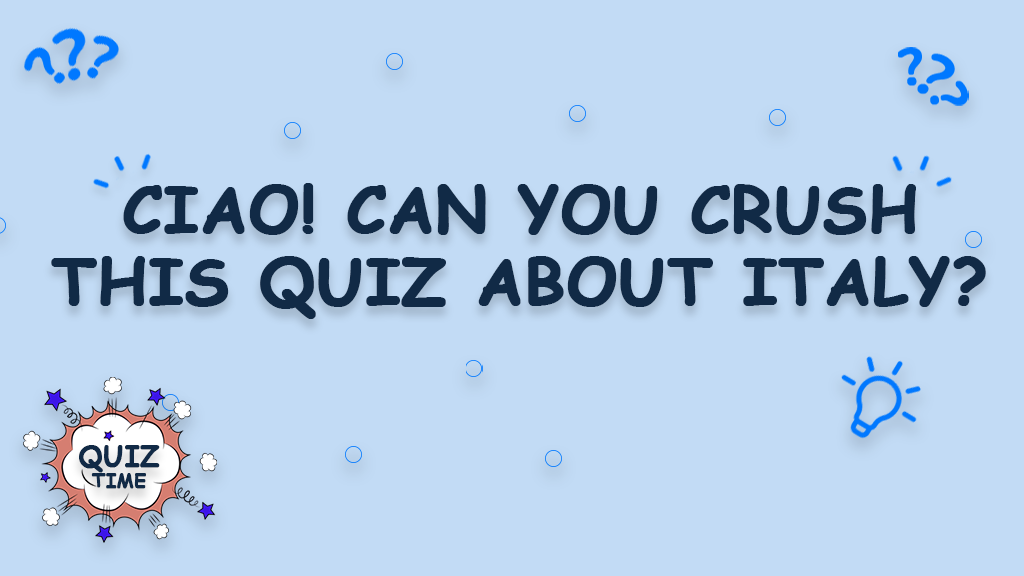❤️It's Trivia, but Sweeter❤️
Ciao! Can You Crush this Quiz About Italy?

Italy is a country rich in history, culture, and tradition. Located in southern Europe, Italy is known for its contributions to art, architecture, cuisine, and politics, with its roots stretching back to ancient civilizations like the Romans. Over the centuries, Italy has become synonymous with a number of iconic landmarks, cities, and cultural practices that continue to draw millions of visitors from around the world each year. Understanding the geographical, historical, and cultural significance of Italy offers a deeper appreciation for its immense impact on both Europe and the world.
One of the key aspects of Italy’s appeal is its vibrant capital, Rome. As the country’s capital city, Rome has served as the center of the Roman Empire and remains one of the most influential cities in history. The city’s iconic landmarks, such as the Colosseum, the Pantheon, and St. Peter’s Basilica, reflect its long and storied past. Rome has also been the epicenter of the Catholic Church, housing the Vatican City, the smallest independent state in the world. For centuries, Rome has attracted artists, thinkers, and travelers, making it a cornerstone of Western culture.
Beyond Rome, Italy is divided into various regions, each with its own unique culture and history. One of the most renowned regions is Tuscany, located in central Italy. Known for its rolling hills, vineyards, and olive groves, Tuscany is a place where history, art, and nature converge. Florence, the capital of Tuscany, is considered the birthplace of the Renaissance, a period of extraordinary cultural growth that changed the course of European history. It was here that artists like Leonardo da Vinci, Michelangelo, and Botticelli worked, creating masterpieces that would forever shape Western art. Tuscany is also famous for its wines, especially Chianti, which has become a staple of Italian culture and cuisine.
Moving south, Italy’s southern regions offer a stark contrast to the cooler, more mountainous north. Sicily, the island located off the southern coast of Italy, has a rich history that blends Greek, Roman, Arab, and Norman influences. The island is home to numerous ancient ruins, including the Valley of the Temples, a UNESCO World Heritage site, and Mount Etna, one of the world’s most active volcanoes. Sicily’s cuisine is equally diverse, reflecting its history of cultural exchange. Dishes like arancini (fried rice balls) and cannoli (sweet pastry filled with ricotta cheese) are beloved not only in Italy but around the world.
Another notable Italian region is Venice, famous for its canals, gondolas, and medieval architecture. Venice is unlike any other city, built on a series of islands connected by a network of canals and bridges. The city has long been a cultural and economic hub, historically serving as a major maritime power during the Middle Ages and Renaissance. Today, Venice remains a popular destination for tourists, with its iconic St. Mark’s Square, the Grand Canal, and the Rialto Bridge drawing millions every year. Venice also hosts the famous Venice Film Festival, which is one of the oldest and most prestigious film festivals in the world.
Italy’s cuisine is another essential part of the country’s cultural identity. Italian food is known for its simplicity, quality ingredients, and bold flavors. Each region of Italy has its own culinary traditions, but some dishes have become internationally recognized and loved. Pizza, for example, originates from Naples, where it was first crafted in the late 18th century. The traditional Neapolitan pizza, with its thin crust, fresh mozzarella, tomatoes, and basil, has become a global favorite. Pasta, of course, is another quintessential Italian dish, with thousands of variations that vary by region. In the north, creamy risottos and hearty meat sauces are common, while in the south, pasta dishes tend to be lighter, often featuring seafood or tomatoes.
Italy’s contributions to the world extend far beyond food and art. The country has a rich tradition of fashion, with Milan being one of the world’s fashion capitals. Italian designers, such as Giorgio Armani, Dolce & Gabbana, and Valentino, have set global trends and shaped the fashion industry for decades. The influence of Italian design is evident not only in clothing but also in furniture, architecture, and even automotive design. Brands like Ferrari, Lamborghini, and Maserati have become synonymous with luxury and precision engineering, while Italian furniture design is recognized for its timeless elegance.
The Italian language itself is a symbol of the country’s cultural richness. Although Italian is the official language of the country, regional dialects are still widely spoken, adding another layer of diversity to the nation’s identity. The Italian language has also made a significant impact on the arts, with its lyrical and musical qualities inspiring operas, songs, and poetry. The great works of Italian writers like Dante Alighieri, Petrarch, and Boccaccio have influenced the development of Western literature, and the Italian language remains central to the world of opera and classical music.
Italy’s political landscape is as intricate as its cultural history. The country is a parliamentary republic with a long tradition of democratic governance. The Italian political system is characterized by a multi-party system, with frequent coalition governments. While the country has faced periods of political instability, particularly in the aftermath of World War II, it has maintained a strong democratic tradition. Italy is also a member of the European Union, the United Nations, and NATO, playing an important role in international diplomacy and economic affairs.
Italy’s economy is one of the largest in Europe, with a diverse industrial base that includes manufacturing, agriculture, and tourism. The country is known for producing high-quality goods, such as luxury fashion items, automobiles, and machinery. Additionally, Italy’s agriculture sector is renowned for its production of olives, wine, and cheeses, many of which are exported around the world. Tourism also plays a significant role in Italy’s economy, with millions of visitors flocking to the country every year to experience its historic cities, picturesque landscapes, and world-class art and culture.
Italy’s sports culture is equally significant, with soccer (football) being the most popular sport in the country. The Italian national football team, known as the Azzurri, has won multiple FIFA World Cup titles and is widely regarded as one of the best teams in international soccer. Italy is also home to some of the most passionate football clubs, including Juventus, AC Milan, and Inter Milan. Cycling is another beloved sport in Italy, with events like the Giro d’Italia attracting fans from around the globe. The country also excels in other sports, such as basketball, volleyball, and winter sports, especially in the alpine regions.
In conclusion, Italy is a country that offers a rich tapestry of history, culture, and tradition. From its iconic cities like Rome, Florence, and Venice to its breathtaking landscapes and world-renowned cuisine, Italy has something to offer everyone. Whether it’s exploring ancient ruins, indulging in delicious food, or experiencing the country’s artistic and architectural wonders, Italy’s charm and beauty continue to captivate people from around the world. The country’s influence on global culture, politics, and economics is profound, and its legacy is one of creativity, passion, and enduring contributions to the world.



